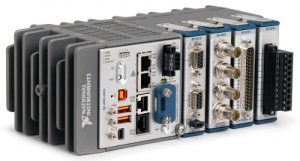
Compact Reconfigurable Input / Output (cRIO) systems from National Instruments (NI), when combined with LabVIEW, can provide the reliable, real-time control often needed (typically for safety reasons). A simple example may be shutting down the equipment in a test cell when someone enters. That would be a poor time for Microsoft to decide that your PC needs to have an update installed. Historically, Programmable Logic Controllers (PLCs) were often used to ensure this level of dedicated monitoring. PLC technology grew out of an even older technology: electromechanical relays. The ancient “programming language” they use is known as Ladder Logic, and it was invented to make programming PLCs similar to wiring relays.
Well, technology has advanced since the days of relays. Powerful microprocessors, like cRIO can run reliably in a real-time environment. They have much more flexibility and power than a PLC, and can be orders of magnitude faster. But, that isn’t the only reason to consider a more modern solution, like NI’s cRIO hardware. It can be programmed with LabVIEW, the leading tool for developing automated systems for test, measurement, and control.
Assuming the system will require some data acquisition (DAQ) hardware anyway, to measure and control electrical signals, using the cRIO platform can provide that, and the general-purpose capabilities of a real-time computer, as well as the formidable power of a Field Programmable Gate Array (FPGA), also programmed with LabVIEW.
The cRIO platform is more expensive than a PLC, in terms of strictly hardware cost. But, if all costs are taken into account, it is arguably less expensive in the long run. The initial development investment would be smaller because even the real-time aspects of the hardware are programmed in LabVIEW, so there is no need to develop and support a separate PLC program. There would be no need to develop drivers for the PLC, and no need for extra communication hardware and software, which would typically require yet more in terms of software development. Furthermore, the single platform can reduce the total number of I/O channels needed, because no channels are needed for communications between the cRIO chassis and the PLC.
Having all the hardware in one chassis simplifies wiring, spare parts requirements, and long-term support. When there is need to update the system, the resource needed to do so need only know LabVIEW, and cRIO, and won’t have to also know PLC hardware and PLC programming.
Likewise, the application software will be better integrated, providing the flexibility to monitor and modify the real-time control aspects that would otherwise be “hidden” within the PLC. The processor within the cRIO platform can perform much of the functionality of the entire test program. It is not restricted to only the functions traditionally performed by a PLC. That, in turn decreases the burden on the central PC, making it much more able to handle multiple cells simultaneously. Having the real-time programming be part of the overall test system (all in LabVIEW).